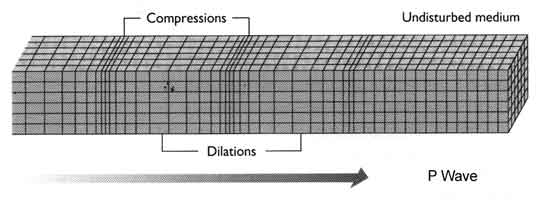Earthquakes
Causes of Earthquakes
Earthquakes occur at fault lines where there is force
created by movement of tectonic plates. The forces
involved are generally described by shear stress and shear
strength. Shear stress is the force the force per unit
area applied to a plane. Shear strain describes the
distortion created by the shear strain.
When shear stress reaches a certain level
at a point in the crust, called local strength, a sudden
failure occurs. This sudden failure releases a large
amount of energy creating dangerous waves.
Types of Waves Created by Earthquakes
Three different types of waves are created by
earthquakes, some are more dangerous than others.
P waves- Also known as "primary waves", are the fastest wave that propagates in the rock. It acts in a similar motion to that of sound waves. The rock is compressed and dilated. These waves will travel through both solid rock and liquids.

S waves- S waves are slower waves
that propagate through rock bodies. The the rock shears at
a right angle to the direction of travel. This kind of
wave does not travel through liquid, but will more
damaging to structures than the P wave.
Surface Waves- Surface waves have
motion that is restricted to the ground near the surface.
There are two kinds, Love waves and Rayleigh waves. Love
waves move side to side in a horizontal movement This is
extremely damaging to structures of buildings. Rayleigh
waves move vertically and horizontally on a vertical
plane.

Graphics Source: http://allshookup.org